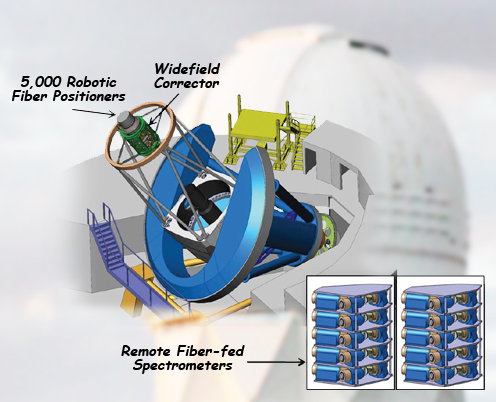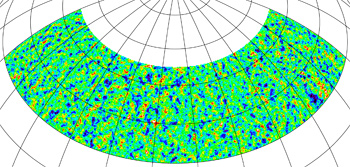
A $2.1 million grant from the Gordon and Betty Moore Foundation to the University of
California at Berkeley, through the Berkeley Center for Cosmological
Physics (BCCP), will fund the development of revolutionary
technologies for BigBOSS, a project now in the proposal stage designed
to study dark energy with unprecedented precision. BigBOSS is based at
the U.S. Department of Energy’s Lawrence Berkeley National Laboratory
(Berkeley Lab).
“BigBOSS is the next big thing in cosmology,” says Uroš Seljak,
Director of the BCCP, who is a professor of physics and astronomy at
UC Berkeley and a member of Berkeley Lab’s Physics Division. “It would
map millions and millions of galaxies, allowing us to measure dark
energy to high precision – and would yield other important scientific
results as well, including determining neutrino mass and the number of
neutrino families.”
Dark energy is the unknown something that appears to account for
almost three-quarters of the mass-energy of the universe and is the
cause of its accelerating expansion. The discovery of the accelerating
universe, announced in 1998 by two teams, resulted in the 2011 Nobel
Prize in Physics, divided between Berkeley Lab and UC Berkeley
astrophysicist Saul Perlmutter, leader of the Supernova Cosmology
Project, and Brian Schmidt and Adam Riess of the competing High‑z
Supernova Search team. “After we won the Nobel Prize, the question we
all heard most was, ‘Now that you’ve discovered dark energy, what
comes next?’” says Perlmutter, who is the Executive Director of the
BCCP as well as principal investigator for the Moore Foundation’s
BigBOSS grant. “The answer is pretty clear: we have to find out what
dark energy is. There’s no end of theories. To know which are
possible, what we need most is the kind of accurate observational
evidence that only BigBOSS and other advanced experiments can give
us.”
Read More


